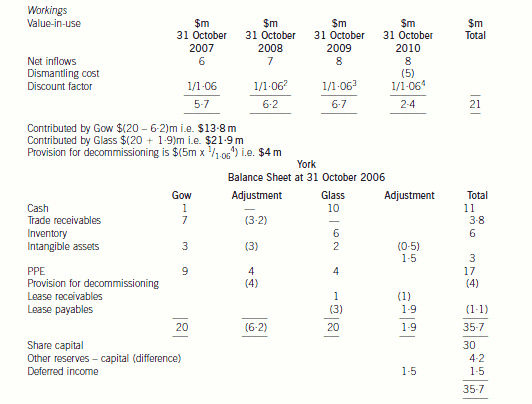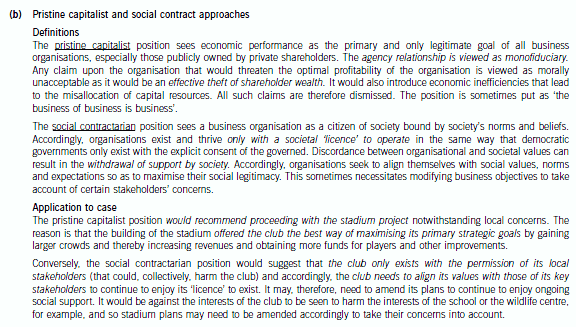参加ACCA考试,掌握这些答题技巧很重要!
发布时间:2020-09-05
要参加2020年ACCA考试的小伙伴注意啦,很多同学在考试答题的时候找不到答题技巧,或者由于紧张导致不必要的丢分,51题库考试学习网为大家带来了ACCA考试时的一些答题技巧,让我们一起来看看吧!
1.填写信息,稳定情绪。
试卷发下来后,立即忙于答题是不科学的,应先填写信息,写清姓名和准考证号等,这样做不仅是考试的要求,更是一剂稳定情绪的“良药”。
2.浏览全卷,区别难易。
打开试卷,看看哪些是基础题,哪些是中档题,哪些是难题或压轴题,按先易后难的原则,确定解题顺序,逐题进行解答。力争做到“巧做低档题,题题全做对;稳做中档题,一分不浪费;尽力冲击高档题,做错也无悔。”按照由易到难的答题顺序,能够让大家有一个缓冲的过程。
3.认真审题,灵活答题。
审题要做到一不漏掉题,二不看错题,三要审准题,四要看全题目的条件和结论。审题中还要灵活运用知识,发现和寻找简便的解题方法。
4.过程清晰,稳中求快。
一要书写清晰,速度略快;二要一次成功;三要提高答题速度;四要科学使用草稿纸;五要力求准确,防止欲速则不达。很多同学在答题时由于速度过慢导致考试时间到了题却没答完,所以大家要分配好时间。
5.心理状态,注意调节。
考试中,要克服满不在乎的自负心理,要抛弃“胜败在此一举”的负重心理,要克服畏首畏尾的胆怯心理。面对难、中、易的试卷,调节好心态,积极应对。
6.尽量多做,分分必争。
ACCA考试评分,通常是按步骤、按知识点、按要点给分,毕竟ACCA考试费用不低。因此,考生在答题时,就要会多少,答多少,哪怕是一条辅助线,一个符号,一小段文字,都可写上,没有把握也要敢于写,千万不要将不能完全做出或答案算不出的题放弃不做。
7.抓住“题眼”,构建“桥梁”。
一般难题都有个关键点(称之为“题眼”),抓住了“题眼”,问题就易于解决了。此外,还要利用相关的知识、规律、信息进行多方联系,构建“桥梁”,找出问题的内在联系,从而构思解题方案,准确、快捷地解决问题。
以上就是今天分享的全部内容了,各位小伙伴根据自己的情况进行查阅,希望本文对各位有所帮助,预祝各位取得满意的成绩,如需了解更多相关内容,请关注51题库考试学习网!
下面小编为大家准备了 ACCA考试 的相关考题,供大家学习参考。
(c) (i) Identify and describe FOUR quality control procedures that are applicable to the individual audit
engagement; and (8 marks)
(c) (i) ISQC 1 Quality Control for Firms That Perform. Audits and Reviews of Historical Financial Information and Other
Assurance and Related Services Engagements provides guidance on the overall quality control systems that should be
implemented by an audit firm. ISA 220 Quality Control for Audits of Historical Financial Information specifies the quality
control procedures that should be applied by the engagement team in individual audit assignments.
Procedures include the following:
Client acceptance procedures
There should be full documentation, and conclusion on, ethical and client acceptance issues in each audit assignment.
The engagement partner should consider whether members of the audit team have complied with ethical requirements,
for example, whether all members of the team are independent of the client. Additionally, the engagement partner should
conclude whether all acceptance procedures have been followed, for example, that the audit firm has considered the
integrity of the principal owners and key management of the client. Other procedures on client acceptance should
include:
– Obtaining professional clearance from previous auditors
– Consideration of any conflict of interest
– Money laundering (client identification) procedures.
Engagement team
Procedures should be followed to ensure that the engagement team collectively has the skills, competence and time to
perform. the audit engagement. The engagement partner should assess that the audit team, for example:
– Has the appropriate level of technical knowledge
– Has experience of audit engagements of a similar nature and complexity
– Has the ability to apply professional judgement
– Understands professional standards, and regulatory and legal requirements.
Direction
The engagement team should be directed by the engagement partner. Procedures such as an engagement planning
meeting should be undertaken to ensure that the team understands:
– Their responsibilities
– The objectives of the work they are to perform
– The nature of the client’s business
– Risk related issues
– How to deal with any problems that may arise; and
– The detailed approach to the performance of the audit.
The planning meeting should be led by the partner and should include all people involved with the audit. There should
be a discussion of the key issues identified at the planning stage.
Supervision
Supervision should be continuous during the engagement. Any problems that arise during the audit should be rectified
as soon as possible. Attention should be focused on ensuring that members of the audit team are carrying out their work
in accordance with the planned approach to the engagement. Significant matters should be brought to the attention of
senior members of the audit team. Documentation should be made of key decisions made during the audit engagement.
Review
The review process is one of the key quality control procedures. All work performed must be reviewed by a more senior
member of the audit team. Reviewers should consider for example whether:
– Work has been performed in accordance with professional standards
– The objectives of the procedures performed have been achieved
– Work supports conclusions drawn and is appropriately documented.
The review process itself must be evidenced.
Consultation
Finally the engagement partner should arrange consultation on difficult or contentious matters. This is a procedure
whereby the matter is discussed with a professional outside the engagement team, and sometimes outside the audit
firm. Consultations must be documented to show:
– The issue on which the consultation was sought; and
– The results of the consultation.
(b) Prepare the balance sheet of York at 31 October 2006, using International Financial Reporting Standards,
discussing the nature of the accounting treatments selected, the adjustments made and the values placed
on the items in the balance sheet. (20 marks)

Gow’s net assets
IAS36 ‘Impairment of Assets’, sets out the events that might indicate that an asset is impaired. These circumstances include
external events such as the decline in the market value of an asset and internal events such as a reduction in the cash flows
to be generated from an asset or cash generating unit. The loss of the only customer of a cash generating unit (power station)
would be an indication of the possible impairment of the cash generating unit. Therefore, the power station will have to be
impairment tested.
The recoverable amount will have to be determined and compared to the value given to the asset on the setting up of the
joint venture. The recoverable amount is the higher of the cash generating unit’s fair value less costs to sell, and its value-inuse.
The fair value less costs to sell will be $15 million which is the offer for the purchase of the power station ($16 million)
less the costs to sell ($1 million). The value-in-use is the discounted value of the future cash flows expected to arise from the
cash generating unit. The future dismantling costs should be provided for as it has been agreed with the government that it
will be dismantled. The cost should be included in the future cash flows for the purpose of calculating value-in-use and
provided for in the financial statements and the cost added to the property, plant and equipment ($4 million ($5m/1·064)).
The value-in-use based on a discount rate of 6 per cent is $21 million (working). Therefore, the recoverable amount is
$21 million which is higher than the carrying value of the cash generating unit ($20 million) and, therefore, the value of the
cash generating unit is not impaired when compared to the present carrying value of $20 million (value before impairment
test).
Additionally IAS39, ‘Financial Instruments: recognition and measurement’, says that an entity must assess at each balance
sheet date whether a financial asset is impaired. In this case the receivable of $7 million is likely to be impaired as Race is
going into administration. The present value of the estimated future cash flows will be calculated. Normally cash receipts from
trade receivables will not be discounted but because the amounts are not likely to be received for a year then the anticipated
cash payment is 80% of ($5 million × 1/1·06), i.e. $3·8 million. Thus a provision for the impairment of the trade receivables
of $3·2 million should be made. The intangible asset of $3 million would be valueless as the contract has been terminated.
Glass’s Net Assets
The leased property continues to be accounted for as property, plant and equipment and the carrying amount will not be
adjusted. However, the remaining useful life of the property will be revised to reflect the shorter term. Thus the property will
be depreciated at $2 million per annum over the next two years. The change to the depreciation period is applied prospectively
not retrospectively. The lease liability must be assessed under IAS39 in order to determine whether it constitutes a
de-recognition of a financial liability. As the change is a modification of the lease and not an extinguishment, the lease liability
would not be derecognised. The lease liability will be adjusted for the one off payment of $1 million and re-measured to the
present value of the revised future cash flows. That is $0·6 million/1·07 + $0·6 million/(1·07 × 1·07) i.e. $1·1 million. The
adjustment to the lease liability would normally be recognised in profit or loss but in this case it will affect the net capital
contributed by Glass.
The termination cost of the contract cannot be treated as an intangible asset. It is similar to redundancy costs paid to terminate
a contract of employment. It represents compensation for the loss of future income for the agency. Therefore it must be
removed from the balance sheet of York. The recognition criteria for an intangible asset require that there should be probable
future economic benefits flowing to York and the cost can be measured reliably. The latter criterion is met but the first criterion
is not. The cost of gaining future customers is not linked to this compensation.
IAS18 ‘Revenue’ contains a concept of a ‘multiple element’ arrangement. This is a contract which contains two or more
elements which are in substance separate and are separately identifiable. In other words, the two elements can operate
independently from each other. In this case, the contract with the overseas company has two distinct elements. There is a
contract not to supply gas to any other customer in the country and there is a contract to sell gas at fair value to the overseas
company. The contract has not been fulfilled as yet and therefore the payment of $1·5 million should not be taken to profit
or loss in its entirety at the first opportunity. The non supply of gas to customers in that country occurs over the four year
period of the contract and therefore the payment should be recognised over that period. Therefore the amount should be
shown as deferred income and not as a deduction from intangible assets. The revenue on the sale of gas will be recognised
as normal according to IAS18.
There may be an issue over the value of the net assets being contributed. The net assets contributed by Glass amount to
$21·9 million whereas those contributed by Gow only total $13·8 million after taking into account any adjustments required
by IFRS. The joint venturers have equal shareholding in York but no formal written agreements, thus problems may arise ifGlass feels that the contributions to the joint venture are unequal.

(c) Briefly describe the principal audit work to be performed in respect of the carrying amount of the following
items in the balance sheet:
(i) development expenditure on the Fox model; (3 marks)
(c) Principal audit work
(i) Development expenditure on the Fox model
■ Agree opening balance, $6·3 million, to prior year working papers.
■ Physically inspect assembly plant/factory where the Fox is being developed and any vehicles so far manufactured
(e.g. for testing).
■ Substantiate costs incurred during the year, for example:
– goods (e.g. components) and services (e.g. consultants) to purchase invoices;
– labour (e.g. design engineers/technicians, mechanics, test drivers) to the payroll analysis;
– overheads (e.g. depreciation of development buildings and equipment, power, consumables) to
management’s calculation of overhead absorption and underlying cost accounts.
■ Review of internal trials/test drive results (e.g. in reports to management and video recordings of events).
■ Reperform. management’s impairment test of development expenditure. In particular recalculate value in use.
Tutorial note: It is highly unlikely that a reasonable estimate of fair value less costs to sell could be made for so
unique an asset.
■ Substantiate the key assumptions made by management in calculating value in use. For example:
– the level of sales expected when the car is launched to advance orders (this may have fallen with the delay
in the launch);
– the discount rate used to Pavia’s cost of capital;
– projected growth in sales to actual sales growth seen last time a new model was launched.
(b) Compare and contrast Gray, Owen and Adams’s ‘pristine capitalist’ position with the ‘social contractarian’
position. Explain how these positions would affect responses to stakeholder concerns in the new stadium
project. (8 marks)

声明:本文内容由互联网用户自发贡献自行上传,本网站不拥有所有权,未作人工编辑处理,也不承担相关法律责任。如果您发现有涉嫌版权的内容,欢迎发送邮件至:contact@51tk.com 进行举报,并提供相关证据,工作人员会在5个工作日内联系你,一经查实,本站将立刻删除涉嫌侵权内容。
- 2019-12-29
- 2020-09-05
- 2020-09-05
- 2021-02-13
- 2020-09-05
- 2021-05-29
- 2020-09-05
- 2020-10-21
- 2021-02-13
- 2021-02-13
- 2020-01-01
- 2019-01-04
- 2020-10-21
- 2020-09-04
- 2019-12-29
- 2021-02-21
- 2020-10-10
- 2021-05-29
- 2021-02-13
- 2020-10-10
- 2021-05-29
- 2021-05-29
- 2020-10-10
- 2020-08-15
- 2021-02-13
- 2020-10-10
- 2020-08-15
- 2021-05-29
- 2020-10-10
- 2020-09-05